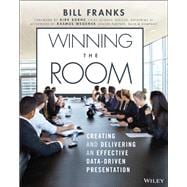In Winning The Room: Creating and Delivering an Effective Data-Driven Presentation, analytics and data science expert Bill Franks delivers a practical and eye-opening exploration of how to present technical data and results to non-technical audiences in a live setting. Although framed with examples from the analytics and data science space, this book is perfect for anyone expected to present data-driven information to others.
The book offers various specific tips and strategies that will make data-driven presentations much clearer, more intuitive, and easier to understand. Readers will discover:
- How to avoid common mistakes that undercut a presentation's credibility
- Instructive and eye-catching visuals that illustrate how to drive a presenter's points home and help the reader to retain the information
- Specific and actionable techniques to dramatically improve a presentation's clarity and impact
Ideal for anyone expected to present to managers, executives, and other business leaders, Winning The Room is required reading for everyone seeking to improve the quality and efficacy of their data-driven presentations and communications.








